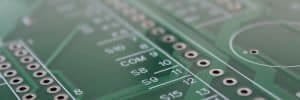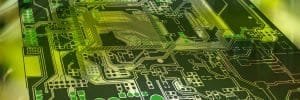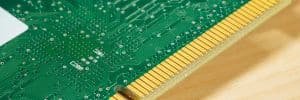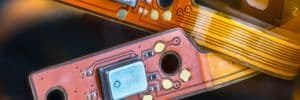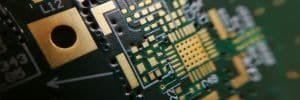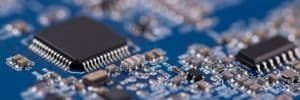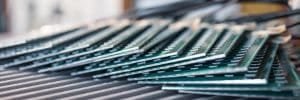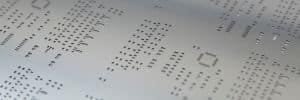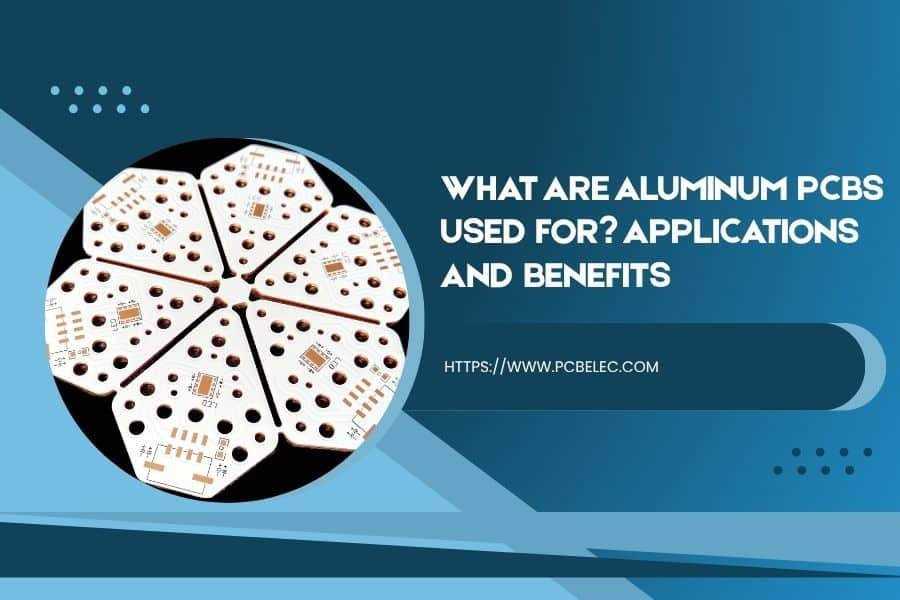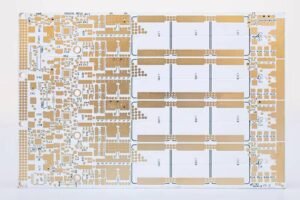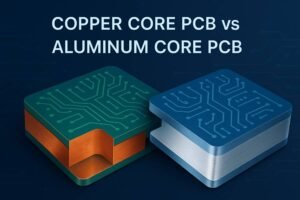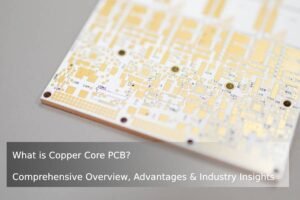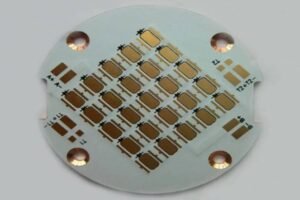Aluminum PCBs are a cornerstone of modern electronics, powering everything from LED lighting to advanced automotive systems. Unlike traditional PCBs that use FR-4 fiberglass substrates, aluminum PCBs leverage an aluminum alloy base, offering superior heat dissipation, durability, and cost-effectiveness. In this guide, we’ll explore what aluminum PCBs are, their types, applications, benefits, and how to choose the right one for your project.
Table of Contents
What Is an Aluminum PCB?
An aluminum PCB is a specialized type of printed circuit board with a metal substrate, typically made from an aluminum alloy. This base material distinguishes it from standard PCBs, providing enhanced thermal conductivity, dimensional stability, and durability. These qualities make aluminum PCBs ideal for high-temperature environments where heat dissipation is critical.
Key Components of Aluminum PCBs
Aluminum PCBs consist of three primary layers:
- Circuit Layer: Made from copper foil, typically thicker than in standard PCBs (e.g., 1-4 oz), allowing higher current capacity for power-intensive applications.
- Dielectric Layer: A thermally conductive, electrically insulating layer, often made from ceramic polymer or epoxy resin, that protects the board from thermal stress.
- Base Layer: An aluminum alloy substrate with high thermal conductivity (typically 1-3 W/m·K), redirecting heat away from critical components.

Why Choose Aluminum PCBs?
Unlike FR-4 PCBs, which may warp or degrade under high temperatures, aluminum PCBs maintain structural integrity, making them suitable for demanding applications like high-power LED lighting.
Learn more about our aluminum PCB manufacturing process.

Types of Aluminum PCBs
Aluminum PCBs are categorized based on their dielectric layer materials or circuit layer structure, each tailored to specific performance needs. Below, we explore the primary types to help you choose the right aluminum PCB for your project.
Based on Dielectric Layer Materials
Universal Aluminum PCB
Utilizes an epoxy glass fiber dielectric layer, offering a cost-effective balance of thermal conductivity (1-2 W/m·K) and electrical insulation.
Applications: General-purpose LED lighting, consumer electronics.
Example: Used in household LED bulbs to ensure reliable heat dissipation at a low cost.High Thermal-Conductive PCB
Features a highly conductive epoxy resin dielectric layer, designed for maximum heat dissipation (up to 3 W/m·K).
Applications: Electric vehicle battery management systems, high-power power supplies.
Example: In EV battery modules, these PCBs reduce operating temperatures by up to 20% compared to FR-4 PCBs.High-Frequency PCB
Employs polyolefin or polyimide resin glass fiber for the dielectric layer, minimizing signal loss in high-frequency circuits.
Applications: RF amplifiers, telecommunications equipment.
Example: Used in 5G base stations to maintain signal integrity at frequencies above 3 GHz.
Based on Circuit Layer Structure
Single-Sided Aluminum PCB
Features a single copper circuit layer on one side of the aluminum substrate, ideal for simple, cost-sensitive designs.
Applications: LED strips, basic power modules.
Advantages: Low cost, easy to manufacture, effective heat dissipation.Double-Sided Aluminum PCB
Includes copper circuits on both sides of the aluminum substrate, connected via thermal vias, supporting more complex designs.
Applications:anasal: Automotive electronics, industrial controls.
Advantages: Enhanced circuit density with excellent thermal performance.Multilayer Aluminum PCB
Combines multiple copper layers with an aluminum core for high-density, high-power applications.
Applications: Communication devices, medical imaging systems.
Advantages: Supports complex circuitry while maintaining superior heat dissipation.
| Type | Dielectric Material | Circuit Layers | Key Applications |
|---|---|---|---|
| Universal | Epoxy Glass Fiber | Single/Double | LED Lighting, Consumer Electronics |
| High Thermal-Conductive | High-Conductive Epoxy Resin | Single/Double | EV Battery Systems, Power Supplies |
| High-Frequency | Polyolefin/Polyimide | Single/Double | RF Amplifiers, 5G Equipment |
| Multilayer | Varies | Multiple | Medical Devices, Telecommunications |
Applications of Aluminum PCBs
Due to their excellent thermal management and durability, aluminum PCBs are used in a wide range of industries. Below are some key applications:
- LED Lighting: Aluminum PCBs are widely used in high-power LED lighting due to their ability to dissipate heat efficiently, ensuring long-lasting performance. For example, streetlights and automotive headlights rely on aluminum PCBs to maintain brightness and reliability.
- Audio Equipment: Amplifiers and high-fidelity audio systems use aluminum PCBs to manage heat generated by power-intensive components, ensuring consistent sound quality.
- Computer Components: Power supplies, floppy disk drives, and cooling systems in computers leverage aluminum PCBs for reliable thermal performance.
- Power Supply Systems: AC-DC adapters, radiators, and insulators incorporate aluminum PCBs to minimize heat buildup in high-power environments.
- Automotive Electronics: In electric vehicles, aluminum PCBs are used in battery management systems (BMS) and power modules, handling thermal loads of up to 3 W/m·K.
- Medical Devices: High-reliability medical equipment, such as imaging systems, uses aluminum PCBs for their durability and thermal efficiency.
Case Study: Aluminum PCBs in Electric Vehicles
In a recent project, JHYPCB supplied aluminum PCBs for an EV manufacturer’s battery management system. The PCBs achieved a thermal conductivity of 2.5 W/m·K, reducing operating temperatures by 20% compared to FR-4 PCBs, enhancing battery life and safety.

Benefits of Aluminum PCBs
Aluminum PCBs offer several advantages over traditional FR-4 PCBs, making them a preferred choice for high-performance electronics:
- Superior Heat Dissipation: With thermal conductivity of 1-3 W/m·K, aluminum PCBs redirect heat away from critical components, extending their lifespan.
- Lightweight Design: Aluminum is lighter than other metal substrates like copper, making it ideal for compact, intricate circuitry.
- Cost-Effective: Aluminum is abundant and affordable, reducing manufacturing costs compared to other high-performance materials like ceramic.
- Enhanced Durability: Aluminum PCBs resist warping and degradation, ensuring reliability in harsh environments.
- Environmentally Friendly: Made with recyclable materials, aluminum PCBs support sustainable manufacturing. Additionally, their use in LED lighting promotes energy efficiency over traditional incandescent bulbs.
Feature | Aluminum PCB | FR-4 PCB |
|---|---|---|
Thermal Conductivity | 1-3 W/m·K | 0.25 W/m·K |
Durability | High | Moderate |
Weight | Lightweight | Moderate |
Cost | Budget-Friendly | Affordable |
Recyclability | High | Moderate |
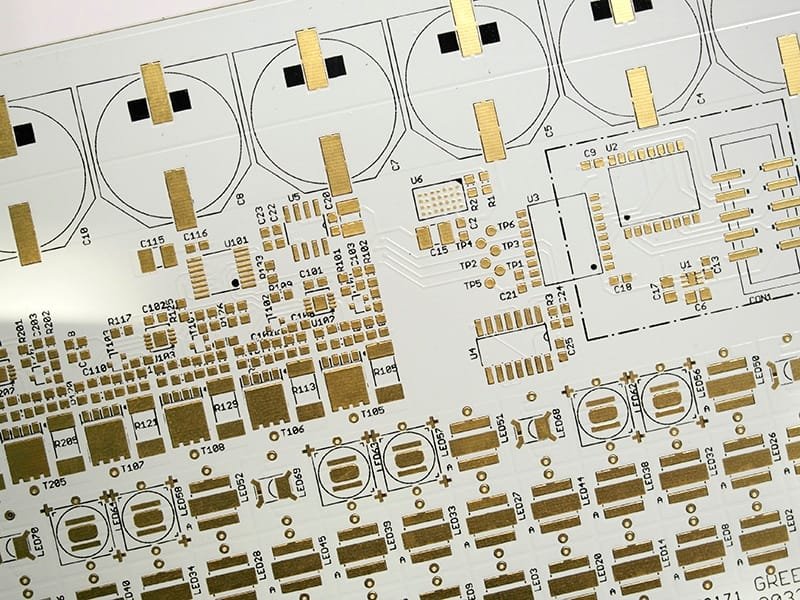
How to Choose the Right Aluminum PCB for Your Project
Selecting the appropriate aluminum PCB depends on your project’s requirements. Consider the following factors:
- Thermal Conductivity Needs: For high-power applications like LED lighting, choose high thermal-conductive PCBs with epoxy resin dielectric layers.
- Frequency Requirements: High-frequency applications, such as RF circuits, benefit from polyimide-based dielectric layers to ensure signal integrity.
- Budget Constraints: Universal aluminum PCBs offer a cost-effective solution for general-purpose applications.
- Board Thickness: Ensure the dielectric layer and copper foil thickness align with your thermal and electrical needs (e.g., 0.5-2 mm dielectric layers for high-power designs).
Why Choose JHYPCB for Aluminum PCBs?
At JHYPCB, we specialize in manufacturing high-quality aluminum PCBs that meet aerospace-grade standards at competitive prices. With over a decade of experience, we combine cutting-edge technology with rapid prototyping to deliver reliable solutions.
- Fast Turnaround: Same-day prototyping and production in as little as seven days.
- Custom Solutions: Wide range of materials and configurations to suit unique project needs.
- Quality Assurance: Adherence to strict tolerance guidelines for optimal performance.
Ready to elevate your electronics with aluminum PCBs? Contact JHYPCB today for a free consultation.
Frequently Asked Questions About Aluminum PCBs
What are the main advantages of aluminum PCBs over FR-4 PCBs?
Aluminum PCBs offer superior thermal conductivity (1-3 W/m·K vs. 0.25 W/m·K for FR-4), greater durability, and a lightweight design, making them ideal for high-power and high-temperature applications.
How do aluminum PCBs improve LED lighting performance?
By efficiently dissipating heat, aluminum PCBs prevent overheating in LEDs, ensuring consistent brightness and extending lifespan by up to 50% compared to standard PCBs.
Can aluminum PCBs be used in high-frequency applications?
Yes, high-frequency aluminum PCBs with polyimide or polyolefin dielectric layers are designed for RF circuits and other high-frequency applications, ensuring minimal signal loss.
How environmentally friendly are aluminum PCBs?
Aluminum PCBs are made with recyclable materials and support energy-efficient applications like LED lighting, reducing environmental impact compared to traditional PCBs.
Related Posts
- Why choose FR4 as the general material of PCB?
- Choosing the Right Metal Core PCB Manufacturer is Critical to Your Success
- Unveil the mystery of high TG PCB circuit boards Materials
- Why is FR4 Used to Make High Tg PCBs?
- The Application of Thermoelectric Separated Copper Core PCB in the Field of LED Heat Dissipation

